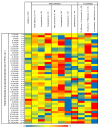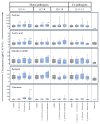Effects of Contagious Respiratory Pathogens on Breath Biomarkers
- PMID: 38397770
- PMCID: PMC10886173
- DOI: 10.3390/antiox13020172
Effects of Contagious Respiratory Pathogens on Breath Biomarkers
Abstract
Due to their immediate exhalation after generation at the cellular/microbiome levels, exhaled volatile organic compounds (VOCs) may provide real-time information on pathophysiological mechanisms and the host response to infection. In recent years, the metabolic profiling of the most frequent respiratory infections has gained interest as it holds potential for the early, non-invasive detection of pathogens and the monitoring of disease progression and the response to therapy. Using previously unpublished data, randomly selected individuals from a COVID-19 test center were included in the study. Based on multiplex PCR results (non-SARS-CoV-2 respiratory pathogens), the breath profiles of 479 subjects with the presence or absence of flu-like symptoms were obtained using proton-transfer-reaction time-of-flight mass spectrometry. Among 223 individuals, one respiratory pathogen was detected in 171 cases, and more than one pathogen in 52 cases. A total of 256 subjects had negative PCR test results and had no symptoms. The exhaled VOC profiles were affected by the presence of Haemophilus influenzae, Streptococcus pneumoniae, and Rhinovirus. The endogenous ketone, short-chain fatty acid, organosulfur, aldehyde, and terpene concentrations changed, but only a few compounds exhibited concentration changes above inter-individual physiological variations. Based on the VOC origins, the observed concentration changes may be attributed to oxidative stress and antioxidative defense, energy metabolism, systemic microbial immune homeostasis, and inflammation. In contrast to previous studies with pre-selected patient groups, the results of this study demonstrate the broad inter-individual variations in VOC profiles in real-life screening conditions. As no unique infection markers exist, only concentration changes clearly above the mentioned variations can be regarded as indicative of infection or colonization.
Keywords: breathomics; metabolic profiling; pulmonary bacteria; real-time mass spectrometry; respiratory virus; volatile biomarkers.
Conflict of interest statement
The authors declare no conflicts of interest.
Figures


Similar articles
-
Profiling of exhaled volatile organics in the screening scenario of a COVID-19 test center.iScience. 2022 Oct 21;25(10):105195. doi: 10.1016/j.isci.2022.105195. Epub 2022 Sep 23. iScience. 2022. PMID: 36168390 Free PMC article.
-
Exhaled breath compositions under varying respiratory rhythms reflects ventilatory variations: translating breathomics towards respiratory medicine.Sci Rep. 2020 Aug 24;10(1):14109. doi: 10.1038/s41598-020-70993-0. Sci Rep. 2020. PMID: 32839494 Free PMC article.
-
In vitro volatile organic compound profiling using GC×GC-TOFMS to differentiate bacteria associated with lung infections: a proof-of-concept study.J Breath Res. 2016 Apr 27;10(2):026008. doi: 10.1088/1752-7155/10/2/026008. J Breath Res. 2016. PMID: 27120170
-
The versatile use of exhaled volatile organic compounds in human health and disease.J Breath Res. 2012 Jun;6(2):027108. doi: 10.1088/1752-7155/6/2/027108. Epub 2012 May 23. J Breath Res. 2012. PMID: 22621865 Review.
-
Breath VOC analysis and machine learning approaches for disease screening: a review.J Breath Res. 2023 Feb 3;17(2). doi: 10.1088/1752-7163/acb283. J Breath Res. 2023. PMID: 36634360 Review.
Cited by
-
Analysis of Bacterial Metabolites in Breath Gas of Critically Ill Patients for Diagnosis of Ventilator-Associated Pneumonia-A Proof of Concept Study.Biomolecules. 2024 Nov 21;14(12):1480. doi: 10.3390/biom14121480. Biomolecules. 2024. PMID: 39766187 Free PMC article.
References
-
- DeMuri G.P., Gern J.E., Eickhoff J.C., Lynch S.V., Wald E.R. Dynamics of Bacterial Colonization with Streptococcus Pneumoniae, Haemophilus Influenzae, and Moraxella Catarrhalis During Symptomatic and Asymptomatic Viral Upper Respiratory Tract Infection. Clin. Infect. Dis. Off. Publ. Infect. Dis. Soc. Am. 2018;66:1045–1053. doi: 10.1093/cid/cix941. - DOI - PMC - PubMed
-
- Zaas A.K., Chen M., Varkey J., Veldman T., Hero A.O., Lucas J., Huang Y., Turner R., Gilbert A., Lambkin-Williams R., et al. Gene Expression Signatures Diagnose Influenza and Other Symptomatic Respiratory Viral Infections in Humans. Cell Host Microbe. 2009;6:207–217. doi: 10.1016/j.chom.2009.07.006. - DOI - PMC - PubMed
Grants and funding
LinkOut - more resources
Full Text Sources
Research Materials
Miscellaneous

